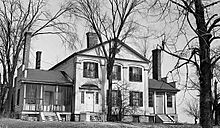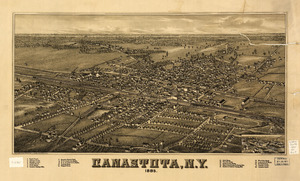Canastota, New York facts for kids
Quick facts for kids
Canastota
Kniste Stota (Oneida)
|
|
|---|---|
|
Village
|
|

Judge Nathan Roberts House on NYS Route 5
|
|
| Country | United States |
| State | New York |
| County | Madison |
| Area | |
| • Total | 3.34 sq mi (8.66 km2) |
| • Land | 3.34 sq mi (8.65 km2) |
| • Water | 0.00 sq mi (0.01 km2) |
| Elevation | 430 ft (131 m) |
| Population
(2020)
|
|
| • Total | 4,556 |
| • Density | 1,364.07/sq mi (526.73/km2) |
| Time zone | UTC-5 (Eastern (EST)) |
| • Summer (DST) | UTC-4 (EDT) |
| ZIP code |
13032
|
| Area code(s) | 315 |
| FIPS code | 36-12188 |
| GNIS feature ID | 0945755 |
Canastota is a small village in Madison County, New York, United States. It is part of the Town of Lenox. In 2020, about 4,556 people lived there.
The village was officially formed in 1835. It was later reorganized in 1870. Canastota is located along the Erie Canal. This important waterway was finished through the Mohawk River valley by 1825. In the mid-1800s, Canastota was a busy trading town. It was an important stop between the cities of Rome and Syracuse.
The part of the canal near the village was no longer used by the 1920s. However, much of it is still there today. It is now part of the Old Erie Canal State Historic Park. Canastota is also famous as the home of the International Boxing Hall of Fame.
Contents
Canastota's History
Early Native Peoples
The name Kniste Stota was used by the local Oneida Nation. It means "cluster of pines near still waters." This was the original name for the area that became Canastota.
The Oneida Nation once lived in this area. They were part of the Haudenosanee confederacy. Before Europeans settled in central New York, their lands covered over six million acres. These lands stretched from the St. Lawrence River to the Susquehanna River.
Captain Reuben Perkins, Founder
Captain Reuben Perkins helped start the village. He was a soldier in the Revolutionary War. He fought in important battles like Plattsburgh and Saratoga. In 1800, Captain Perkins moved his family to a log cabin.
In 1810, he bought about 329 acres of land from the Oneida Nation. He settled his family permanently at what is now James Street and Main Street. Captain Perkins later won a contract to build two miles of the Erie Canal through Canastota. He also worked as its superintendent.
The Erie Canal's Impact
Building the Erie Canal through Canastota began in 1817. When this historic waterway opened between 1819 and 1825, the area grew quickly. Many workers and their families moved to Canastota. Soon, schools, businesses, and churches appeared.
Once this part of the canal opened, boats called "packets" started regular trips. They traveled between Syracuse and Utica, stopping at all towns along the way. Canastota became a major trading center in central New York. The first post office opened in 1829. By 1831, the village had three hotels, three stores, and a hat-making business. The population reached 406 people.
Later, railroads and the New York Thruway became more important for trade. Some canal towns, including Canastota, became less central to commerce.
Liberty Party Convention
In September 1852, an important meeting took place in Canastota. The national convention of the Liberty Party was held at the Dutch Reformed Church. This party was against slavery.
Delegates shared reports about how people felt about ending slavery in their areas. Famous speakers like Frederick Douglass, Gerrit Smith, and Jermain Wesley Loguen attended. They discussed whether the party should choose its own presidential candidate. Or if they should support another party's candidate.
In 2022, the 170th anniversary of this convention was celebrated. A special marker was placed where the meeting happened.
The Great Fire of 1873
On October 26, 1873, a big fire started in a hay barn east of the village. The barn and sixty tons of hay burned completely.
Early the next morning, another fire began on Spencer Street. It quickly spread to the Eagle Hotel and other buildings. Strong winds helped the fire spread fast. Many blocks were destroyed, leaving only smoking ruins. Over thirty buildings were completely burned down.
No deaths were reported right away. However, many people had serious burns on their faces and hands. They worked hard to save their belongings from the burning buildings. Many of the village's early records were lost in this fire.
Gerrit Smith, a famous abolitionist, sent a letter and $1000 to help. He wrote, "Let not Canastota despair. She has still more left than she has lost."
Historic Races and Tornadoes
The famous 1908 Race from New York to Paris drove right through Canastota.
More recently, on July 16, 2024, an EF1 tornado hit the town. The tornado caused significant damage and sadly, there was a loss of life.
Canastota's Geography
Canastota covers about 3.3 square miles (8.6 square kilometers). All of this area is land.
Population Information
| Historical population | |||
|---|---|---|---|
| Census | Pop. | %± | |
| 1840 | 800 | — | |
| 1850 | 900 | 12.5% | |
| 1860 | 1,081 | 20.1% | |
| 1870 | 1,492 | 38.0% | |
| 1880 | 1,569 | 5.2% | |
| 1890 | 2,774 | 76.8% | |
| 1900 | 3,030 | 9.2% | |
| 1910 | 3,247 | 7.2% | |
| 1920 | 3,995 | 23.0% | |
| 1930 | 4,235 | 6.0% | |
| 1940 | 4,150 | −2.0% | |
| 1950 | 4,458 | 7.4% | |
| 1960 | 4,896 | 9.8% | |
| 1970 | 5,033 | 2.8% | |
| 1980 | 4,773 | −5.2% | |
| 1990 | 4,673 | −2.1% | |
| 2000 | 4,425 | −5.3% | |
| 2010 | 4,804 | 8.6% | |
| 2020 | 4,556 | −5.2% | |
| U.S. Decennial Census | |||
In 2000, Canastota had 4,425 people living in 1,872 households. Most residents were White (97.31%). About 25.3% of the population was under 18 years old. The average age in the village was 37 years.
Canastota's Economy
Canastota has very rich soil. This made it a great place for farming in Central New York. It supplied many vegetables to the region. In the late 1800s and early 1900s, many Italian families moved here. They became farmers and bought land.
The village was sometimes called the "onion capital of the world." Onions once brought in a lot of money for the village.
Canastota was also a place for inventions!
- In the 1850s, Charles Spencer built special microscopes here.
- In 1893, David S. Watson moved his wagon company, Watson Wagons, to Canastota. These wagons were unique because they could drop their contents from the bottom. They were used in farming, waste management, and even in World War I.
- Herman Casler of Canastota invented the Biograph. This was an early movie machine. The first movies shown with the Biograph were in Canastota.
- In 1904, Harry D. Weed invented the Tire chain. He patented his invention while working in Canastota.
Arts and Culture in Canastota
Canastota has 16 places listed on the National Register of Historic Places. One of these is the Canastota Canal Town Museum.
The village is also famous for boxing. Two world boxing champions, Carmen Basilio and Billy Backus, came from Canastota. This is why the International Boxing Hall of Fame is located here.
Famous People from Canastota
- Billy Backus, a former World Welterweight boxing champion.
- Carmen Basilio, a former World Welterweight and Middleweight boxing champion.
- Milton De Lano, a former US Congressman.
- Edmund Giambastiani, an admiral in the US Navy.
- Margaret Shulock, a cartoonist.
See also
 In Spanish: Canastota para niños
In Spanish: Canastota para niños



